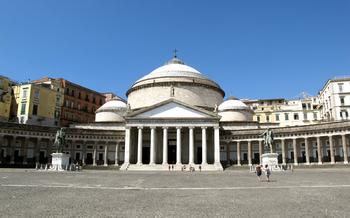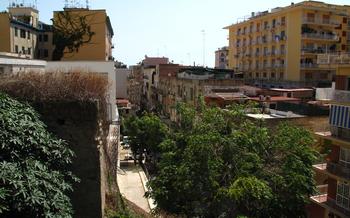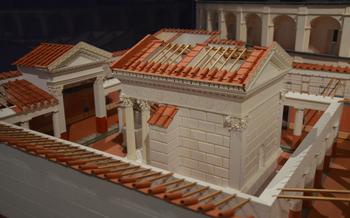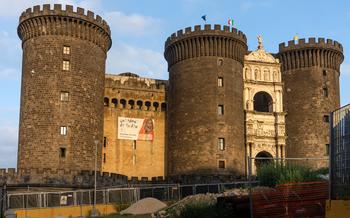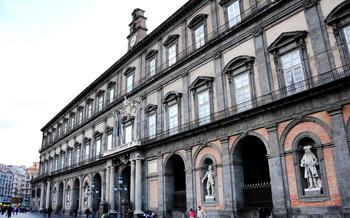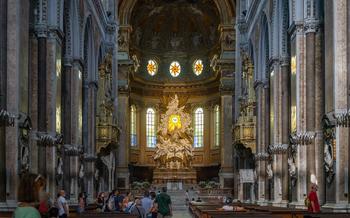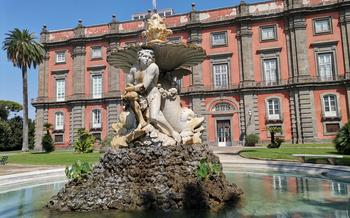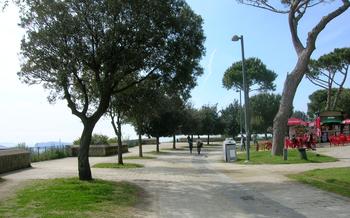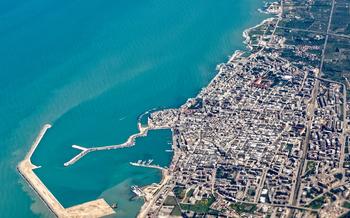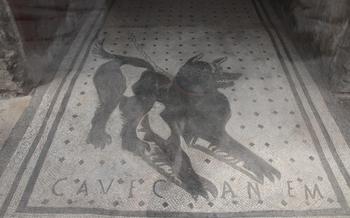
Real Albergo dei Poveri
- The Real Albergo dei Poveri: A Journey Through History and Splendor
- The Historical Background of the Real Albergo dei Poveri
- The Architectural Marvel of the Real Albergo dei Poveri
- Intricate Frescoes
- Impressive Statues
- The Chapel of the Archangel Michael: A Heavenly Masterpiece
- Caravaggio's "The Seven Works of Mercy"
- Educational Programs
- Decline and Restoration
- Current Exhibitions and Events
- Stunning Views
- Accessibility
- Opening Hours and Admission Fees
- Guided Tours
- Insider Tip:
The Real Albergo dei Poveri: A Journey Through History and Splendor
Naples, a vibrant and historic city in southern Italy, boasts a rich tapestry of culture and art. Among its many landmarks, the Real Albergo dei Poveri stands as a testament to the city's grandeur and its commitment to social welfare. Founded in the 18th century, this magnificent complex was once a charitable institution dedicated to housing and educating the orphaned and impoverished children of Naples. Today, it has been lovingly restored and transformed into a cultural and historical attraction that welcomes visitors from around the world.
The Historical Background of the Real Albergo dei Poveri
Nestled in the heart of Naples, Italy, the Real Albergo dei Poveri stands as a testament to the city's rich history and philanthropic spirit. Its story begins in the 18th century, when King Charles III of Bourbon, deeply affected by the plight of Naples's poor and orphaned children, commissioned the construction of this grand institution. Designed by the renowned architect Ferdinando Fuga, the Real Albergo dei Poveri was intended to be a charitable haven, providing shelter, education, and vocational training to those in need.
The institution's establishment marked a turning point in the city's social welfare system, as it aimed to address the rampant poverty and illiteracy that plagued Naples at the time. The Real Albergo dei Poveri became a beacon of hope for the city's most vulnerable population, offering them a chance to break the cycle of poverty and gain the skills necessary to lead productive and fulfilling lives.
Over the centuries, the Real Albergo dei Poveri played a crucial role in shaping Naples's cultural and social landscape. It served as a center of learning and artistic expression, with its workshops and studios producing skilled artisans and craftsmen who contributed to the city's flourishing arts and crafts scene. The institution's commitment to education extended beyond vocational training, as it also offered classes in literacy and general knowledge, empowering its residents to become active and informed citizens.
Despite facing challenges and periods of decline over the years, the Real Albergo dei Poveri remained a symbol of hope and resilience for the people of Naples. Its legacy continues to inspire and guide the city's efforts to address social inequality and promote social mobility, ensuring that future generations have access to the opportunities they need to thrive.
The Architectural Marvel of the Real Albergo dei Poveri
The Real Albergo dei Poveri is a testament to the architectural brilliance of the 18th century. Designed by the renowned architect Ferdinando Fuga, the building showcases the grandeur of the Baroque style. Its imposing facade, characterized by intricate carvings, pilasters, and a majestic central portal, sets the stage for the wonders that await within.
As visitors step into the sprawling courtyard, they are greeted by a harmonious ensemble of arches, columns, and balconies. The rhythmic repetition of architectural elements creates a sense of visual unity and balance. The courtyard, with its central fountain, serves as a gathering place, inviting visitors to pause and admire the architectural masterpiece that surrounds them.
The interior of the Real Albergo dei Poveri matches the grandeur of its exterior. Visitors can wander through vast hallways, adorned with intricate frescoes and sculptures. The grand staircases, with their sweeping curves and ornate balustrades, lead to upper floors, where visitors can explore the building's many chambers and rooms.
The architectural details of the Real Albergo dei Poveri are not merely decorative; they carry symbolic meaning. The facade, with its allegorical figures representing Charity and Abundance, reflects the building's original mission as a charitable institution. The sculptures and frescoes throughout the building depict scenes from mythology, history, and religion, serving as visual narratives that educate and inspire visitors.
Overall, the Real Albergo dei Poveri stands as a shining example of Baroque architecture, a testament to the skill and artistry of its creators. Its grandeur, symmetry, and symbolism combine to create a building that is both visually stunning and intellectually stimulating.
Intricate Frescoes
The Real Albergo dei Poveri is adorned with breathtaking frescoes that grace its walls and ceilings, creating a visual feast for visitors. These exquisite works of art depict religious scenes, mythological tales, and allegorical representations, transforming the building into a veritable gallery of Baroque masterpieces.
Among the most notable frescoes is the grand ceiling fresco in the main hall, painted by Francesco Solimena. This awe-inspiring artwork depicts the "Glory of the Immaculate Conception," showcasing the Virgin Mary surrounded by a celestial host of angels and cherubs. The intricate details, vibrant colors, and dynamic composition of the fresco create a sense of grandeur and spirituality that leaves visitors in awe.
Another highlight is the series of frescoes in the Chapel of the Archangel Michael, painted by Paolo de Matteis. These works depict scenes from the life of the archangel, including his battle with the devil and his triumph over the forces of evil. De Matteis's masterful use of light and shadow, combined with his expressive figures and vivid colors, brings the biblical narratives to life, creating a deeply immersive and emotional experience for viewers.
These frescoes are not merely decorative elements but also serve as powerful tools of storytelling and religious instruction. They reflect the deep faith and devotion of the Neapolitan people, and they continue to inspire and captivate visitors centuries after their creation.
Impressive Statues
The Real Albergo dei Poveri is adorned with a collection of impressive statues that add to its grandeur and historical significance. These statues, both inside and outside the building, serve as artistic expressions and symbols that reflect the institution's mission and values.
The main courtyard features a series of statues representing the virtues that were instilled in the children who lived and studied at the institution. These virtues include Charity, Prudence, Justice, and Temperance, each depicted with distinct attributes and expressions. The statues, crafted by renowned sculptors of the time, add a touch of solemnity and moral guidance to the courtyard's ambiance.
Inside the building, visitors can find statues depicting various historical figures and religious figures. Among them is a statue of Saint Francis of Paola, the patron saint of Naples, which holds a prominent position within the chapel. The statue is a testament to the deep religious devotion that permeated the institution and the city as a whole.
These statues not only serve as decorative elements but also provide valuable insights into the history, values, and artistic traditions of Naples. They offer a glimpse into the institution's past and the importance it placed on moral education and religious faith.
The Chapel of the Archangel Michael: A Heavenly Masterpiece
Nestled within the majestic halls of the Real Albergo dei Poveri, the Chapel of the Archangel Michael stands as a testament to the spiritual grandeur of this iconic landmark. Designed by the renowned architect Ferdinando Fuga, the chapel exudes an aura of tranquility and devotion that captivates visitors from the moment they step inside.
The chapel's Baroque interior is a feast for the eyes, featuring intricate frescoes, opulent marble altars, and a breathtaking dome adorned with celestial artwork. The centerpiece of the chapel is the stunning altarpiece, which depicts the Archangel Michael vanquishing the devil, symbolizing the triumph of good over evil.
Visitors can immerse themselves in the chapel's serene atmosphere, marveling at the delicate details of the frescoes, which depict scenes from the life of the archangel and other biblical narratives. The skillful use of light and shadow creates a dramatic effect, enhancing the chapel's mystical ambiance.
The Chapel of the Archangel Michael is not just a place of worship but also a testament to the artistic and spiritual heritage of Naples. Its existence within the Real Albergo dei Poveri serves as a reminder of the institution's dedication to providing not only physical sustenance but also spiritual nourishment to the underprivileged children it once cared for.
Caravaggio's "The Seven Works of Mercy"
Among the artistic treasures housed within the Real Albergo dei Poveri, one standout is Caravaggio's renowned painting, "The Seven Works of Mercy." Created in 1607, this masterpiece depicts the seven acts of charity as described in the Bible. Caravaggio's unique style and masterful use of light and shadow bring the scene to life, capturing the essence of compassion and human suffering.
The painting showcases Caravaggio's signature tenebrism technique, emphasizing the contrast between light and dark to create a dramatic effect. The composition is simple yet powerful, with the figures arranged in a pyramidal structure, drawing the viewer's attention to the central act of charity. Caravaggio's realism and attention to detail are evident in the expressions and gestures of the subjects, conveying a sense of empathy and emotional depth.
"The Seven Works of Mercy" is not only a testament to Caravaggio's artistic genius but also holds significant historical and religious value. The painting was commissioned by the Confraternity of the Pio Monte della Misericordia, a charitable organization dedicated to providing assistance to the poor and sick. Caravaggio's depiction of the works of mercy reflects the organization's mission and serves as a reminder of the importance of compassion and helping those in need.
Today, "The Seven Works of Mercy" is a highlight of the Real Albergo dei Poveri's collection, drawing visitors from around the world who come to admire Caravaggio's masterpiece and experience the power of his art.
Educational Programs
The Real Albergo dei Poveri was not only a shelter for the poor and orphaned children of Naples; it was also an educational institution. The children were taught to read and write, as well as various vocational skills. These skills included tailoring, shoemaking, carpentry, and weaving. The girls were also taught how to cook and sew. The educational programs at the Real Albergo dei Poveri were designed to help the children become self-sufficient and to contribute to society.
The institution's commitment to education was evident in its library, which contained over 20,000 volumes. The library was open to the public, and it was a popular destination for scholars and students. The Real Albergo dei Poveri also had a theater, where plays and concerts were performed. The theater was used to educate the children about culture and the arts.
The educational programs at the Real Albergo dei Poveri were a success. Many of the children who attended the institution went on to become successful members of society. They worked as teachers, doctors, lawyers, and merchants. Some of them even became artists and writers. The Real Albergo dei Poveri played an important role in reducing poverty and illiteracy in Naples. It also helped to create a more educated and cultured citizenry.
Decline and Restoration
The Real Albergo dei Poveri faced a period of decline in the 19th and 20th centuries, mirroring the social and economic challenges of the time. The institution struggled to maintain its charitable mission, and the number of residents dwindled. As a result, the building fell into disrepair, and its once-vibrant halls and classrooms fell silent.
In the mid-20th century, there was a growing recognition of the historical and cultural significance of the Real Albergo dei Poveri. Efforts began to restore the building to its former glory and to revitalize its educational and cultural mission. Extensive restoration work was undertaken, and the building was carefully renovated to preserve its original architectural features.
The restoration project was a success, and the Real Albergo dei Poveri reopened its doors in 1999 as a cultural and historical attraction. Today, it stands as a testament to the resilience and spirit of the Neapolitan people.
Current Exhibitions and Events
The Real Albergo dei Poveri isn't just a static historical monument; it's a vibrant cultural hub that hosts a variety of exhibitions, events, and cultural activities throughout the year. These events breathe new life into the old structure, making it a dynamic and engaging space for visitors.
Exhibitions showcasing local artists, historical artifacts, and contemporary art installations frequently grace the halls of the Real Albergo dei Poveri. These exhibitions provide a platform for emerging and established artists to display their work, while also offering visitors a glimpse into the rich cultural heritage of Naples.
In addition to exhibitions, the Real Albergo dei Poveri also hosts various cultural events, such as concerts, theater performances, and literary readings. These events transform the building into a stage, where artists and performers bring their talents to life, creating a lively and interactive atmosphere.
One of the highlights of the cultural calendar is the annual "Real Albergo dei Poveri Summer Festival." This festival takes place during the summer months and features a diverse lineup of live music, dance performances, and outdoor cinema screenings, all set against the backdrop of the stunning courtyard.
Whether you're interested in art, history, or simply seeking a unique cultural experience, the Real Albergo dei Poveri offers a wide range of events and exhibitions to cater to your interests. Be sure to check the official website or inquire at the information desk for the latest updates on upcoming events.
Stunning Views
For breathtaking panoramic vistas of Naples and its surroundings, make sure to visit the terrace and windows of the Real Albergo dei Poveri. The elevated position of this historical landmark offers unparalleled views of the city's rich tapestry of architecture, with iconic landmarks like the Castel Nuovo and the Duomo standing out against the vibrant urban backdrop. Gaze upon the sparkling waters of the Gulf of Naples, where the azure sea meets the distant horizon. On a clear day, you can even catch a glimpse of majestic Mount Vesuvius, the legendary volcano that dominates the Neapolitan skyline. These stunning views from the Real Albergo dei Poveri provide a unique perspective that captures the essence of Naples, a city bursting with life, history, and natural beauty.
Accessibility
Reaching the Real Albergo dei Poveri is a breeze, whether you prefer to navigate the city's charming streets on foot or take advantage of the convenient public transportation options. If you're a wanderer at heart, start your journey from the vibrant heart of Naples, Piazza Garibaldi, and embark on a leisurely 20-minute stroll that will lead you straight to the Albergo's imposing gates. Along the way, immerse yourself in the city's lively atmosphere, marveling at the architectural wonders that line the streets.
Alternatively, hop on the efficient public transportation system. Board the Metro Line 1 (Linea 1) and disembark at the Museo station. From there, it's merely a 5-minute walk to the Albergo. Embrace the opportunity to soak in the local culture as you navigate your way through the city's bustling streets, teeming with life and energy.
For those with limited mobility or who prefer a more relaxed journey, taxis are readily available in Naples. Simply hail one from the street or arrange for a pickup in advance. The friendly and helpful locals are always willing to assist you in finding the best transportation option that suits your needs.
Opening Hours and Admission Fees
The Real Albergo dei Poveri is open to the public from Tuesday to Sunday, from 9:00 AM to 5:00 PM. The landmark is closed on Mondays, as well as on specific holidays such as Christmas Day and New Year's Day. It is advisable to check the official website or contact the tourist information center for any updates or changes to the opening hours.
Admission to the Real Albergo dei Poveri is free of charge, allowing visitors to explore this architectural marvel without any financial constraints. This free admission policy makes it accessible to everyone, encouraging locals and tourists alike to delve into the history, art, and cultural significance of this iconic landmark.
Guided Tours
For an in-depth and enriching experience, consider booking a guided tour of the Real Albergo dei Poveri. These tours are available in multiple languages, ensuring that visitors from all over the world can delve into the history and significance of this iconic landmark. Knowledgeable and passionate guides will lead you through the grand halls, elaborate chapels, and hidden corners of the building, sharing captivating stories and anecdotes that bring the past to life. With a guided tour, you'll gain a deeper understanding of the charitable mission of the institution, the artistic masterpieces that adorn its walls, and the educational initiatives that shaped the lives of countless individuals. Embrace the opportunity to explore this architectural marvel and uncover its rich tapestry of history, culture, and art with the guidance of an expert.
Insider Tip:
Venture beyond the main courtyards and explore the hidden gems of the Real Albergo dei Poveri. In a secluded corner, nestled among the towering buildings, you'll find a charming secret garden, an oasis of tranquility amidst the grandeur of the complex. Take a moment to stroll through its winding paths, admire the blooming flowers, and soak in the serene atmosphere. This hidden retreat offers a unique perspective of the Albergo's rich history and provides a peaceful respite from the bustling city.
